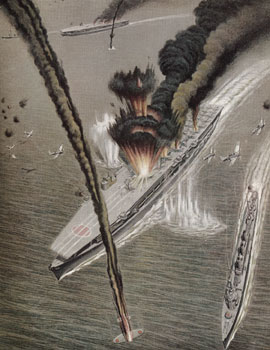| Victory at Midway
My grandfather, Griffith Baily Coale, started the U.S. Navy's combat artist program in 1941. He was a mural painter by trade in New York City. He also wrote about his experiences in two books. I have been putting his writings and paintings up on a site called Griff's Story. (I work at it in fits and starts. I need to get back at it.)
He wrote North Atlantic Patrol and Victory at Midway. I have both books online.
The following was 60 years ago.
Victory at Midway Chapter 8 The Battle

June 4th
Midnight, 0000, the zero hour. A second ticks and another day is born in darkness. The Navy patrol bombers sweep on seaward, streaming through the night, bearing their adopted loads of deadly torpedoes. Above the pilots’ heads the big twin engines protrude beyond the wings, drone hoarsely in the sky. In the long narrow bodies abaft the wings, the blisters bulge like insects’ eyes. There, cramped on small stools, the machine-gunners squat, or stand for stretching. The slim tunnel of the metal fuselage is dark and filled with noise. Officers and crew are alert at their dim stations. The leading ship rises on an air wave, dips down, as the following PBY’s rise and fall in turn. Monotonously the unseen swells undulate through the formation, as the waning moon casts her cold pale light on the stiff and rigid wings. The mysterious rays weakly, indistinctly touch the dark obscure sea—a detached, unreal world below.
The planes now are slowly turning north to intercept the eastward moving enemy. Two hours before dawn they find the same force, a dusky line, stretching below across their path. Unobserved, the leader peels off and drops stealthily down like a hawk from the sky, followed at once by the others in turn. Down they swoop on the unsuspecting prey. Ten big ships in two columns rush up out of the darkness, growing bigger, blacker, fast. Six enlarging destroyers divulge their curving trails. “Let go ! “—and the first torpedo dives into the sea, aimed toward the big ship that will pass ahead. The second plane launches her long tube at the next ship, and another plane dives in for a shot at the second column. Alarm sounds throughout the surprised Jap force as the planes zoom up, over, and away into the sky. Above the racket of the ships’ guns come the two shuddering thumps, the bright columns of fire and white water, as the tin fish explode in their targets. Circling in her climb aloft, the last plane sees the sinking transport’s stern rise up—the heavy list of the big cargo ship, dead in the dark water. She also gets indications of another large force nearby, all still bearing 261º from Midway—distance 500 miles.
This attack at night by the Catalinas was a daring and historic feat. For two of the planes to be able to press home their attacks unobserved was a stunning exploit.
The ships were apparently riding a weather front, bearing down on Midway from the northwest under the protecting clouds. One carrier had been reported yesterday among the ships west of Midway, but this contact was not verified.
[read more] |

